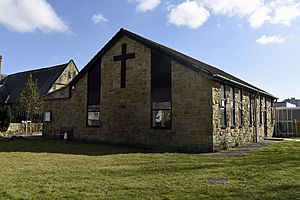Holy Trinity Church, Bingley facts for kids
Quick facts for kids Holy Trinity Church, Bingley |
|
|---|---|
 |
|
| Country | England |
| Denomination | Church of England |
| Weekly attendance | 150 per week |
| History | |
| Status | Parish Church |
| Dedicated | 5 December 1975 |
| Architecture | |
| Functional status | Active |
| Administration | |
| Parish | Holy Trinity, Bingley |
| Deanery | Airedale |
| Archdeaconry | Bradford |
| Diocese | Leeds |
Holy Trinity Church is an Anglican parish church located in the town of Bingley, West Yorkshire, England. It is well-known because its original church building was taken down using explosives on 7 April 1974. Today, it is a busy church serving the local community.
Church History
Before 1868, Bingley had only one main church, the Church of All Saints. This church was in the northern part of the town. During the 1800s, Bingley's population grew a lot because of the Industrial Revolution. The old church became too full to hold everyone.
So, a decision was made to create a new church area, called a parish. On 8 May 1869, the local council voted to set up a new church in this area. The new parish would include places like Gilstead, Cottingley, and parts of the growing town of Bingley.
The plans for the new church showed an Italian Gothic style. Some people thought it looked too much like a Roman Catholic church. However, the famous art critic John Ruskin visited Bingley in 1881. He said the church had a 'severe simplicity and dignity'. Another expert, Pevsner, later described it as "disappointing" and "dark".
The first Holy Trinity Church was officially opened on 23 October 1868. It was designed by a Victorian architect named Richard Norman Shaw. The church was built without a tower at first, but one was added later. However, the foundations for the tower were not strong enough. As early as 1882, people noticed the tower was unsafe. A large stone even fell down during a church service, which surprised everyone.
In 1973, cracks started appearing in the church building. The tower had to be supported with scaffolding so parts of it could be taken down safely. Two weeks before the church was demolished, workers at the top of the tower heard loud creaking and groaning sounds. This led to many nearby houses being evacuated for safety.
Experts, including architects and demolition specialists, decided that using explosives was the only safe way to bring down the church. So, the tower and the rest of the church were demolished by explosives on Palm Sunday in 1974. The church members worked hard and raised £23,000 to build a new church on the same spot. This new building was officially opened on 5 December 1975. It is still used today. The beautiful stained glass from the old church's windows was reused in the new church's Rose Window.
A Sunday school was started next to the church in 1870 and opened in 1871. This school, now known as Holy Trinity School, became a full-day school for boys and girls in 1872.
The Holy Trinity parish also includes St Wilfred's Church in Gilstead. Together with the parish of All Saints, Bingley (which includes St. Aidan's in Crossflatts and St. Lawrence's in Eldwick), they form the Bingley Group Ministry. The church used to be part of the Diocese of Bradford. However, since 20 April 2014, it is now part of the Diocese of Leeds.
Past Vicars of Holy Trinity
Here is a list of the vicars who have led Holy Trinity Church over the years. This information comes from a booklet about the church's history and local records.
| Name | Years in Role | Notes |
|---|---|---|
| Reverend Albert Hudson | 1868–1877 | |
| Reverend H L Williams | 1877–1888 | |
| Reverend F W Bardsley | 1888–1910 | |
| Reverend F A Hodd | 1910–1923 | |
| Reverend H W Sherwin | 1923–1926 | |
| Reverend P Sowerby | 1927–1932 | |
| Reverend G S Addison | 1932–1935 | |
| Reverend A Langford Jones | 1935–1937 | The Lady Chapel in the old church was named in his memory. |
| Reverend R H Place | 1938–1944 | |
| Reverend Hugh Hunter | 1944–1954 | He was made an Honorary Canon of Bradford Cathedral in 1948. |
| Reverend A R Gaunt | 1955–1958 | |
| Reverend W H McLaren | 1960–1965 | |
| Reverend Peter Amor | 1965–1972 | |
| Reverend John Holford | 1973–1986 | |
| Reverend John Cooper | 1987–1992 | |
| Reverend Andrew Clarke | 1993 – Present | He is the current vicar. |

